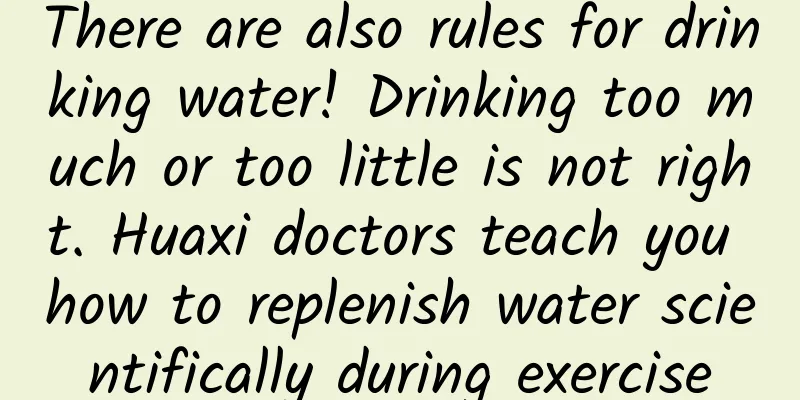There are also rules for drinking water! Drinking too much or too little is not right. Huaxi doctors teach you how to replenish water scientifically during exercise

|
Before running a marathon: Shoot and run score 2 minutes 20 seconds After running a marathon: Supply station crazy wonton, skewers, Bobo chicken I ate for ten minutes and forgot to run. Everyone is concerned about your results. Only editor Concerned about whether you can drink water What’s so particular about drinking water? Isn’t it just a matter of drinking when you’re thirsty? If you sweat too much during exercise and don't replenish water in time, you may become dehydrated. It's not just thirsty, you may also experience loss of concentration, fever, muscle cramps, nausea and vomiting, and rapid heartbeat. Got it. Just drink more water. Drinking too much water can also lead to "water poisoning"! Symptoms such as diarrhea, vomiting, and unconsciousness may occur. In fact, there are many things to pay attention to when replenishing water during exercise Improper way of drinking water Can easily cause physical discomfort Severe cases may even be life-threatening! Let’s take a look at it with Dr. Huaxi today How to do it during exercise Drink water correctly and scientifically 1 Thirsty Thirst is the most obvious sign of dehydration during exercise, and it is the first "alarm" that the body sounds for us. Image source: Photo Network When we exercise, we sweat a lot, which causes a decrease in water in our body. The thirst center in the brain is stimulated due to lack of water, thus forming a subjective feeling of "thirst" in our brain. 2 Difficulty concentrating When you are dehydrated, the blood flow to the brain will decrease, the brain will lack nutrients and oxygen, and you will feel "dizzy". 3 Body fever When we are dehydrated, our body reduces sweating in order to reduce water loss. The amount of water evaporated from the skin decreases, the heat dissipation capacity weakens, and the large amount of heat generated by our exercise cannot be effectively discharged, resulting in a feeling of heat. Image source: Photo Network 4 Muscle cramps As the amount of water decreases, the blood becomes concentrated and the blood calcium concentration increases, while excessive calcium ions will stimulate the skeletal muscles to continue contracting, causing muscle cramps. Image source: Photo Network 5 Nausea and vomiting When you are dehydrated, it is easy to have electrolyte imbalances, especially low potassium and low sodium! This can lead to nausea and vomiting. Image source: Photo Network 6 Fast heartbeat A decrease in the body's blood volume will trigger the body's "stress" response, the sympathetic nervous system will be activated, and blood pressure and heart rate will increase. Marathon runners, please take a look here. If you want to run smoothly on the track, scientific hydration is the key! Before exercise: "Store water" in advance to get full energy Drink 400-600 ml of water or sports drinks 2-3 hours before exercise. Electrolytes and carbohydrates are the body's power "additives". For example, if you compete at 9 am, you should "store water" in advance at 6 to 7 am! During exercise: Regular refueling to ensure long battery life During exercise, the body is like a high-speed machine that loses water continuously, so you need to replenish 150-300 ml of "energy water" every 15-20 minutes. If the weather is hot or you sweat easily, you can increase the amount appropriately. But don't exceed 300 ml! If the exercise time is less than 1 hour, you can just drink ordinary water; if the exercise time exceeds 1 hour, you need to drink sports drinks containing electrolytes to save the sodium, potassium, etc. lost with sweat and prevent muscles from "strike". Image source: soogif After exercise: quickly "recover blood" and restore vitality After exercise, the body is like a warrior after a battle and urgently needs to "restore blood". At this time, quickly drink 200-300 ml of water or sports drinks , and then increase the amount according to the body's "instructions". Pair it with foods rich in carbohydrates and protein such as bananas and yogurt to help the body restore energy and repair muscles. When dehydration unfortunately occurs, don't panic, we can take the following measures for emergency treatment: Rehydrate in small amounts and frequently↓ ↓ ↓ Once you discover that you are dehydrated, you should replenish water as soon as possible, but do not drink a large amount of water at once like you would when you are thirsty. The correct way is to drink about 150-200 ml of water or sports drinks each time, and drink it several times , just like watering dry land little by little, allowing the water to be slowly absorbed by the body. Replenish electrolytes ↓ ↓ ↓ In addition to water, electrolyte supplementation is also very important! Electrolytes such as sodium and potassium play a key role in maintaining the excitability of our body's nerves and muscles, acid-base balance, and the distribution of water in the body. So how do we replenish electrolytes? We can eat foods rich in electrolytes, such as bananas. A small banana contains about 300-400 mg of potassium. Eating a banana during the game can effectively replenish potassium . Image source: Photo Network In addition, you can also choose special electrolyte effervescent tablets or salt pills and take them according to the recommended dose in the instructions. Seek medical help ↓↓↓ If the symptoms of dehydration are severe and are not relieved after replenishing water and electrolytes on our own, or if emergency situations such as confusion or coma occur, you must immediately stop the ongoing activity and seek medical help . Medical personnel will take appropriate treatment measures according to the severity of dehydration to correct the dehydration and ensure our life safety. When it comes to treating dehydration, medical professionals have three main approaches: assessment, rehydration, and treatment of the cause. The first axe Assess dehydration and respond accordingly First, you need to understand the enemy situation and the severity and type of dehydration: Mild dehydration (3% to 5% body weight loss) The first signs of dehydration may just be a feeling of thirst and a loss of skin elasticity, but the overall condition is still OK. Moderate dehydration (6 to 9 percent body weight loss) Heart rate increases and urine output is as low as a malfunctioning faucet. Severe dehydration (weight loss ≥10 percent) The skin is pale, the limbs are limp, the consciousness is blurred, and shock may even occur. Of course! Assessment is not as simple as just looking at the surface. To fully understand the situation, you need to combine medical history, physical examination, and laboratory tests to draw a reliable conclusion! Second Axe Accurate fluid replacement requires technical skills! ● Patients with acute dehydration or shock For patients with acute dehydration or shock, medical staff may use crystalloid fluids (such as normal saline or lactated Ringer's solution) by rapid intravenous infusion at a dose of 20 mL/kg, observe the patient's response, and then decide whether to give a second round. If it is hyperosmotic dehydration, intravenous infusion should be done slowly, because too fast a speed may cause cerebral edema. Patients with mild to moderate dehydration For patients with mild to moderate dehydration, treatment should be rhythmic: 1. Replenish half of the lost body fluid quickly: replenish half of the lost body fluid within 6 hours, every second counts! 2. Slowly replenish the rest: The remaining dehydrated amount should be slowly filled in the next 18 hours. If the patient can drink it, then leave it to oral rehydration salts, which are almost the trump card for diarrhea and dehydration. The third axe The root cause of dehydration Dehydration is actually a symptom, and the underlying problem is the culprit. For example: ● Infectious diarrhea? Use a two-pronged approach of anti-infection and fluid rehydration. ● Diabetic ketoacidosis? Arrange insulin and fluid replacement. Only by cutting off the cause of the disease can dehydration be prevented from recurring. To sum it up in one sentence: the "three axes" of dehydration treatment are accurate assessment, wonderful fluid replacement, and thorough treatment of the cause, stable, accurate and ruthless! Prepare water, salt and sugar, which can help you replenish lost electrolytes. The method is very simple: Prepare 4 1/4 cups of water (about 1060 ml); 1/2 teaspoon of salt (about 3g); 2 tablespoons of sugar (about 30g); Mix well. If you have requirements for taste, you can follow the following recipe: 3/4 cup (175 ml) apple, grape, or grapefruit juice (100% juice) Add 3 1/4 cups water (about 810 ml); Add half a teaspoon of salt (about 3g); Just mix well. This kind of homemade electrolyte water is especially suitable for after exercise or in hot weather, helping the body restore water and minerals and maintain electrolyte balance. Finally, some tips to remind you Drink more water at work, and you will have smooth sailing (But don’t drink too much. The Dietary Guidelines for Chinese Residents recommends that in mild climates, adult men should consume 1,700 ml of water per day and women 1,500 ml.) Statement: This article is a medical-related educational popular science article. It does not involve specific treatment methods or medical behaviors and cannot replace hospital visits. Author This article is guided by the teacher References [1]Armstrong, LE Rehydration during Endurance Exercise: Challenges, Research, Options, Methods. Nutrients 13 (2021). https://doi.org/10.3390/nu13030887 [2] Zang Tong. Scientific hydration during sports. Modern Food, 70-71 (2016). https://doi.org/10.16736/j.cnki.cn41-1434/ts.2016.22.027 [3] Zhu Tiefeng & Zhao Weiwei. Analysis on the importance of scientific hydration in sports. Sports and Recreation Technology, 136-138 (2024). [4]https://www.albertahealthservices.ca/assets/info/nutrition/if-nfs-ors-recipes.pdf Content Production Edit: 100% sweet Map: Eastern Zhou Dynasty |
>>: What is the difference between the Lunar South Pole Station and the Earth's South Pole Station?
Recommend
New media operations: 1 formula and 6 principles to create new media content
This article will provide a systematic explanatio...
Fishing, hunting birds, and being inclusive, the life of ancient people 70,000 years ago was far better than that of the "crazy primitive man"
In the Paleolithic Age, ancient ancestors fished ...
BMW Brilliance invests 2.8 billion in CATL, scramble for high-quality battery supply
On July 17, CATL announced that it had signed a s...
Four major advertising channels and budget planning in 2019!
It is estimated that digital media advertising sp...
The latest chapters of The School Belle’s Personal Bodyguard are free to read, and the chapters of The School Belle’s Personal Bodyguard are updated!
A peerless master who came out of the mountains, ...
Inventory and marketing analysis report of influencers’ advertising during Double Eleven 2020
This report mainly reviews the policies, marketin...
If you press and hold WeChat for 2 seconds, so many hidden functions will appear. How many of them have you used?
WeChat is one of the most familiar mobile apps in...
Why do young women who don't smoke get lung cancer? The reason may not be what you think!
During the National Cancer Prevention and Treatme...
What are the functions of Huizhou WeChat Beauty Mini Program? How much does it cost to develop a skin care product mini program?
The most profitable industry nowadays is the &quo...
Telecom Server Rental Price List
The price of server rental is affected by many fa...
14 writing monetization lessons: Get started quickly and make money quickly even if you have no basic knowledge
14 writing monetization lessons: Get started quic...
Interpreting ASP.NET 5 & MVC6 Series (14): View Component
In previous MVC, we often need a function similar...
What qualifications are required for Foshan’s knowledge payment mini program? What are the features?
WeChat, as the largest traffic portal on mobile t...
Estimated time for Changchun City to be unsealed in 2022: When will it be fully unsealed? Attached are the conditions for lifting the lockdown!
According to the latest report, from 0:00 to 24:00...
Event operation and promotion: How to design a good lottery event?
This article analyzes and discusses how to design...









